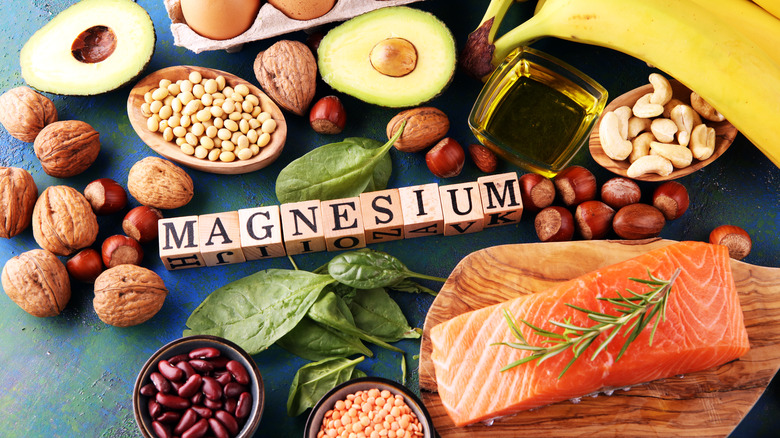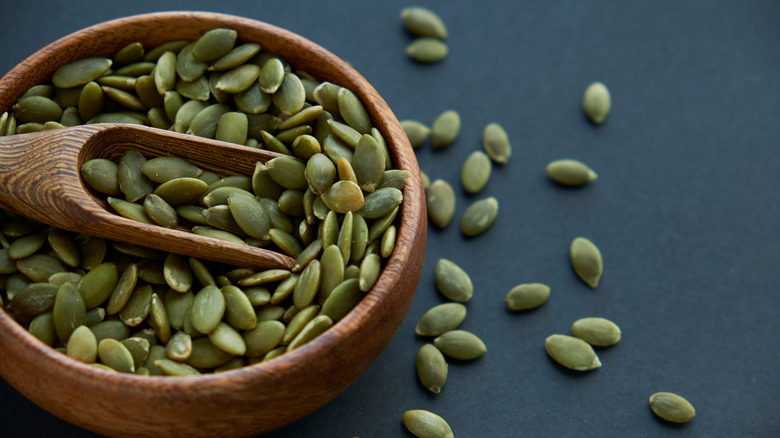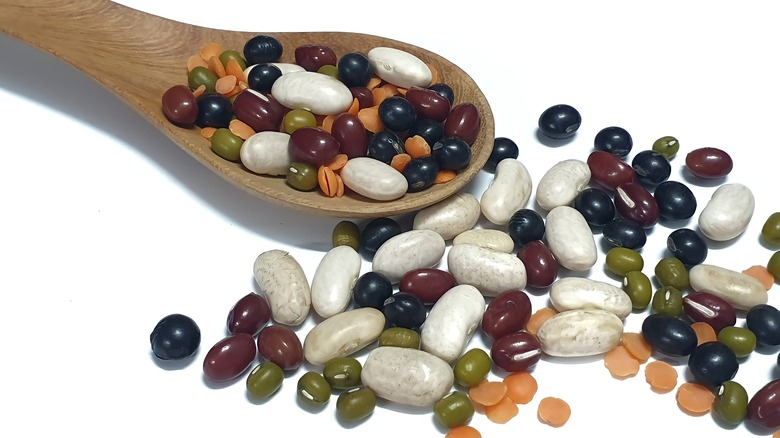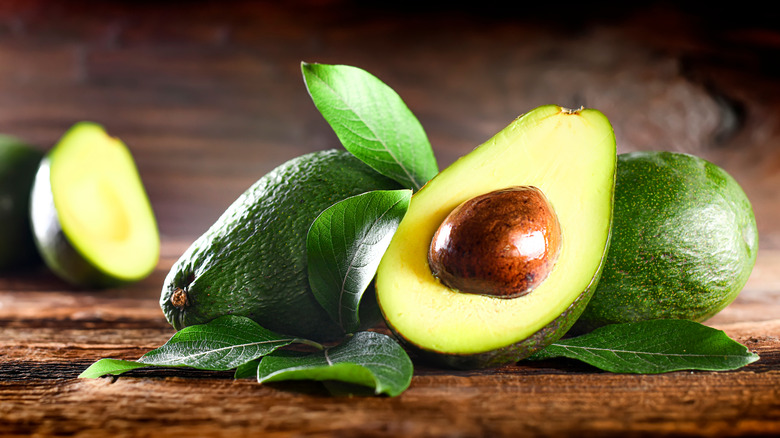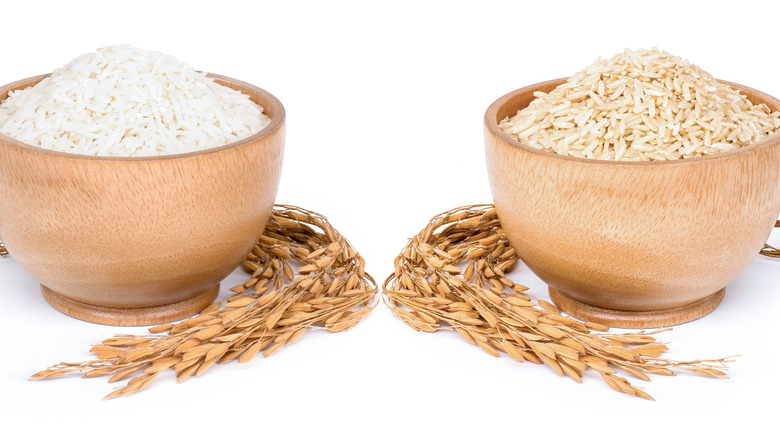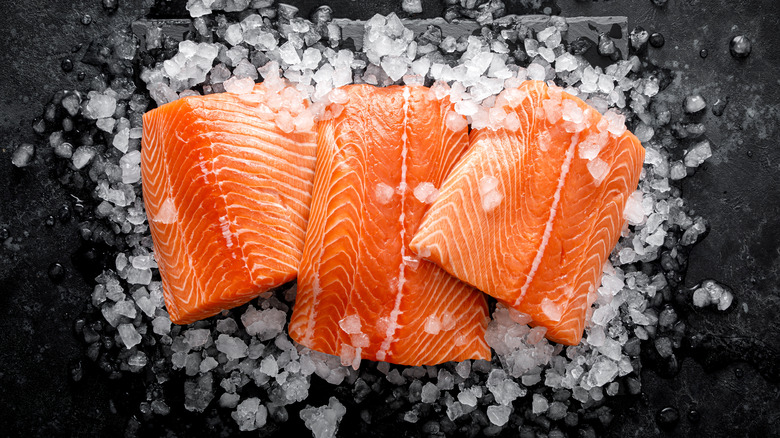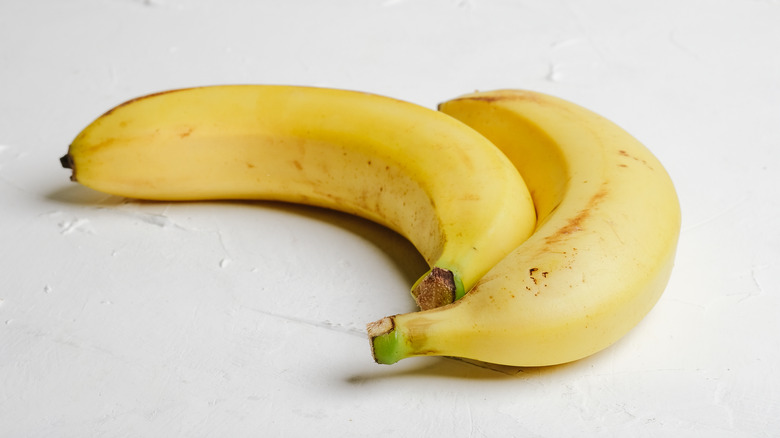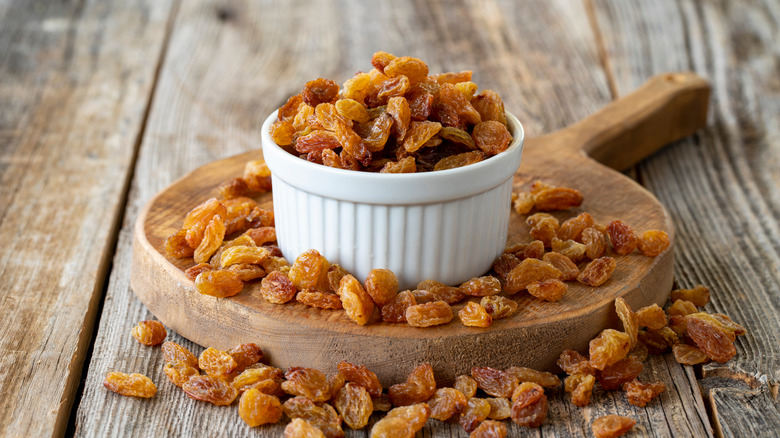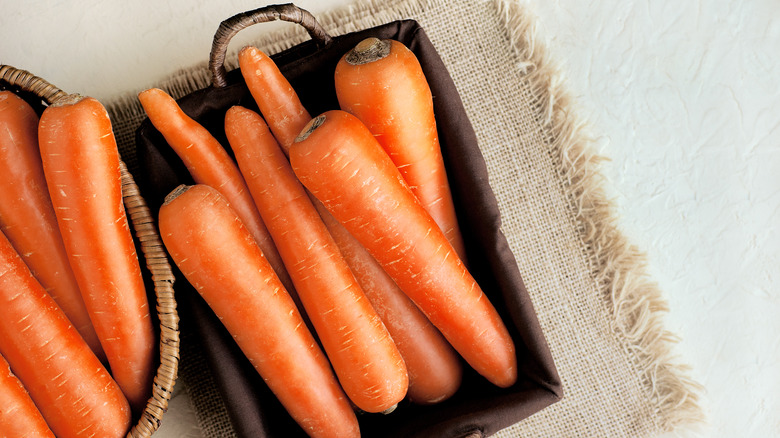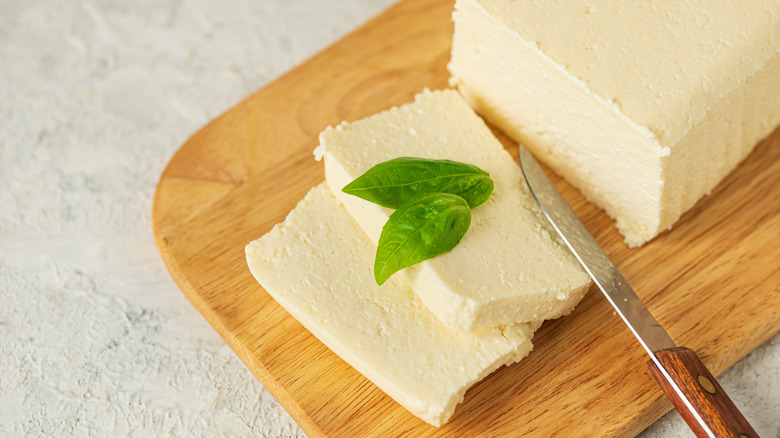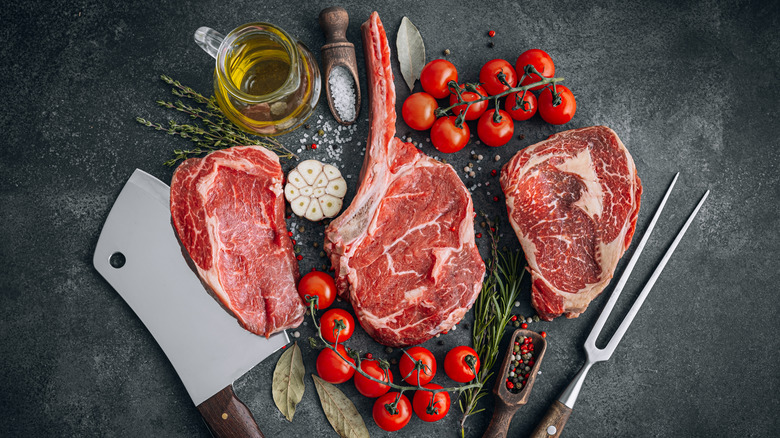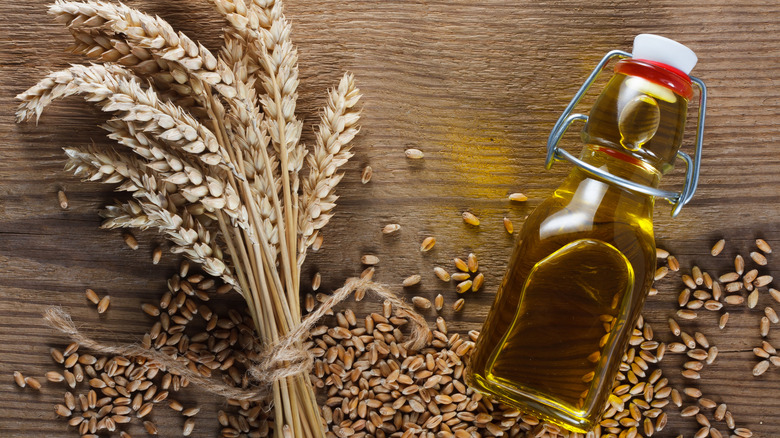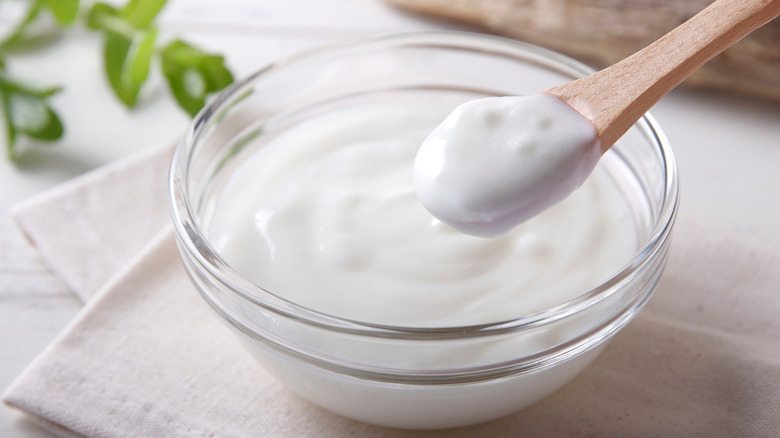Foods You Should Eat If You Need More Magnesium
We may receive a commission on purchases made from links.
Magnesium is not something that we often find at the forefront of our minds, but this mineral is essential to keep our bodies functioning. In fact, experts believe that most adults in the U.S. do not consume enough magnesium-rich foods (via WebMD). However, as one of the more important electrolytes, magnesium helps our bodies thrive when the balance within our cells is optimal. Consuming the right amount of magnesium is vital to ensure our bones stay strong, our blood pressure in check, and our heartbeats rhythmic. WebMD states that the recommended daily allowance (RDA) spans between 300 and 400 mg per day based on your age, gender, and whether or not you are pregnant or breastfeeding.
Some diseases and conditions can lead to a deficiency in magnesium, but deficiencies tend to be rare. They are most commonly found in individuals who have kidney disease, chronic alcoholism, Crohn's disease, celiac disease, or in those who take specific drugs for diabetes or cancer treatment. Healthy people typically do not need to worry about a true deficiency, but should also prioritize consuming magnesium-rich foods to maintain the proper equilibrium. According to the Cleveland Clinic, consuming magnesium supplements that go beyond the RDA and are not prescribed by your doctor is not recommended, as this often results in gastrointestinal distress. So, if you're looking to up your magnesium intake the safe and healthy way, here is a list of foods to snag on your next grocery run.
Spinach
Spinach is just, like, a wonder leaf. It is mind-blowing how much nutrition is packed into one cup of raw spinach. One cup of raw spinach contains around 25 mg of magnesium, making it a rich dietary source (per Medical News Today). This shot of magnesium is coupled with calcium and potassium, two other electrolytes that our bodies crave. And, yes, Popeye, a double-dose of spinach includes around a quarter of the RDA of iron. The iron in spinach is best absorbed when consumed with foods rich in vitamin C, which sounds like the perfect opportunity to enjoy a fruity spinach salad for dinner, yum.
The magnesium in spinach can help your immune system and metabolism function properly. Maintaining the proper electrolyte balance within your cells helps ensure that your muscles and nerves function properly. Beyond that, magnesium is responsible for many of the biochemical reactions that take place within your body. Loading your plate up with a few handfuls of these dark green little leaves is one way to help make sure that your body is firing on all cylinders.
Pumpkin seeds
If you think that eating pumpkin seeds only makes sense after carving your Halloween pumpkins, think again! It turns out that pumpkin seeds pack a huge magnesium punch and should be consumed all year round, not just as a side effect to Halloween festivities. A one-ounce serving of pumpkin seeds contains almost 40% of the RDA for magnesium, with that amount dishing out around 150 mg (via Healthline). Just imagine how much magnesium you could consume by tossing a scoop of pumpkin seeds on your spinach salad!
That healthy dose of magnesium is coupled with heart-healthy omega-3 fatty acids, a whole buncha fiber, and monounsaturated fats, which is one of the healthiest kinds of fat to consume. Chia seeds and flaxseeds also provide a hearty dose of magnesium, though slightly less than pumpkin seeds. If you are looking to conveniently up your magnesium intake, enjoying seeds on a salad, in a smoothie, or by the fistful is a great place to start.
Black beans
Much like seeds, legumes tend to be good sources of magnesium. One of the most magnesium-rich legumes is none other than the humble black bean (via Medical News Today). They contain a ton of fiber and protein, in addition to having a comprehensive vitamin and mineral content. Black beans contain magnesium, potassium, phosphorus, manganese, copper, and zinc. All of these elements work together to provide you with strong and healthy bones.
According to Medical News Today, about 60% of the body's magnesium is stored within your bones. This is yet another reminder to drive home the importance of maintaining your bone health. Luckily for us, black beans help our bones stay strong while also providing the magnesium that our bodies want to stash. A half-cup serving of black beans contains around 60 mg of magnesium and nearly 2 mg of iron (around the same as a two-cup serving of spinach). Adding a scoop of black beans to your meals is one way to include more magnesium, but also a way to make Taco Tuesday a little bit healthier.
Dark chocolate
The rumors are true! Dark chocolate is a dessert with many health benefits, and we just couldn't be happier about it (via Healthline). It is one thing to pack your plate with vegetables in the name of health; it is a whole different kind of joy to indulge in a dessert that you know provides health benefits. Dark chocolate is incredibly rich in magnesium, with a one-ounce serving providing around 16% of the RDA. And to be honest, how often are you just consuming a one-ounce square? By doubling your serving, you could be consuming upwards of 130 mg of magnesium for dessert.
Dark chocolate also contains iron, manganese, antioxidants, and prebiotics. Prebiotics are important for helping to feed the beneficial flora within your gut. In addition, the antioxidants in dark chocolate provide age-defying destruction to free radical accumulation. They also support the annihilation of "bad" cholesterol (LDL). Your best bet when it comes to selecting dark chocolate is to opt for the versions that contain at least 70% cocoa/cacao mass. The higher the cocoa content, the more nutrition and health benefits you stand to soak up.
Avocados
Tom Brady popularized avocado ice cream as one of his go-to, healthier-than-average treats (via Boston.com). And, well, calling avocado ice cream a treat is about as polarizing as Brady's career — some people named their dogs after him, others can't stand the sight of him ever since 2015's deflategate. But it turns out that avocado ice cream, and avocados at large, are a great source of magnesium. Whether you love him, hate him, love to hate him, or have never heard of him, Tom Brady's diet is on point, as this dessert offers up more magnesium than the standard Ben and Jerry's.
One medium-sized avocado provides us with nearly 60 mg of magnesium (per Healthline). With that amount being around 15% of the RDA, tossing an avocado on your spinach salad is a surefire way to ensure your daily magnesium needs are met. Additionally, avocados are high in "good" fats, the monounsaturated kind that have been proven to increase heart health and help ward off certain diseases. Avocados can also help reduce inflammation, another component that assists in maintaining overall health.
Brown rice
Brown rice is often viewed as the heartier version of its fluffy white counterpart. Indeed, not all rice is created equal. White rice is essentially rice that used to be brown (via Healthline). The bran and germ are removed throughout its processing to create a slightly more savory flavor. However, stripping rice of its natural components also strips away much of its nutrient profile, including the amount of magnesium it contains.
One half-cup serving of brown rice provides around 11% of the RDA for magnesium, around 40 mg. Conversely, the same size serving of white rice contains around 10 mg, even after the final product has been fortified before being sold for consumption. Even so, enjoying white rice can provide some magnesium, just not in plentiful amounts, as is the case with brown rice.
Healthline reminds us that consuming a diet rich in magnesium can help our bodies carry out many of its vital functions. These functions include blood coagulation, bone development, cellular production, and muscle contractions, which can only properly occur when electrolytes are balanced.
Salmon
Whether you're a fan of sushi, lox, poached salmon, or simply love a grilled fillet, salmon is a great staple food for those looking to increase their magnesium intake. While some fish should be avoided due to high heavy metal content, salmon is generally safe to consume in moderation (via Healthline). Salmon and tuna are both healthy choices to satisfy your craving for fish, and both provide substantial amounts of magnesium.
A three-ounce serving of salmon contains around 25 mg of magnesium, which can definitely put a dent into fulfilling the recommended daily amount (per Cleveland Clinic). Salmon's magnesium comes with a side order of other healthy compounds, too. This includes vitamin D and omega-3 fatty acids. Omega-3 fatty acids have been shown to improve heart health and decrease the risk of heart disease and strokes. The American Heart Association recommends eating two servings of healthy fish per week for optimum benefits. Beyond just its nutrient density, some research suggests a link between fish consumption and a lowered rate of mental health disorders (per Indian Journal of Psychiatry).
Bananas
It seems like most people cite bananas as a strong source of potassium, another necessary electrolyte (per Everyday Health). But did you know that bananas also deliver magnesium? They contain around 32 mg of magnesium per serving, but this naturally varies depending on the size of the banana. Bananas are an easy and portable way to work toward hitting your magnesium goals for the day.
While bananas are great for replenishing electrolytes lost during exercise — just ask any marathon runner — they also provide a few other healthy compounds that help our bodies run smoothly. They contain fiber, which literally makes things move more smoothly through the digestive tract, and also vitamin C. The vitamin C and magnesium work together to help support your immune system and assist in collagen production, which helps maintain healthy connective tissues, bones, and, of course, luminous, radiant skin.
Some people like to demonize bananas because of their "high" sugar content (via Everyday Health). But those 14 grams of sugar come bundled with so many nutrients that it doesn't make sense to omit bananas from your diet (unless you're allergic, of course). They are fat free and truly help give your body and muscles what they need to perform their jobs. It sounds like Curious George is on the right track....
Raisins
We aren't sure if raisins are a polarizing food or if they are just universally despised (via Cosmopolitan UK). Regardless, they are an excellent source of magnesium, so it would behoove us all to erase their #badreputation from our collective memories and approach these little dehydrated grapes with more of an open mind. Visualize those tiny boxes of raisins that your parents put in your lunchbox every day throughout elementary school — that is a one-ounce serving of raisins. Pretty small to an adult, right? Well, just that amount of raisins provides 15 mg of magnesium (via Medical News Today).
They also contain calcium, potassium, phosphorus, sodium, and a small amount of vitamin C. Most excitingly, one ounce of raisins contains nearly .80 mg of iron. Even vegetarians who choose to eat only spinach salads can consume plenty of iron and magnesium by adding a few raisins into the mix. According to Medical News Today, raisins contain quite a few antioxidants, which help combat the oxidative stress that your body incurs on a day-to-day basis. Moreover, the antioxidants that are abundant in raisins are more bioavailable than those found in other fruits, making them that much more valuable when it comes to our health!
Carrots
Yes, the adults in your life have been right all along. Carrots are really good for you, and you should be eating them regularly, especially if you are in the mood to increase your magnesium intake. One cup of chopped carrots provides around 3% of the RDA of magnesium, or around 12 mg (via Diet & Fitness Today). And while chowing down on an entire cup of carrots seems like a daunting and jaw-exhausting task, adding some chopped carrots to a summer salad is a colorful and easy way to incorporate more magnesium into your diet.
The rumors about carrots helping your eyesight are true, kind of. Typically, the brighter the color of the vegetable or fruit, the more nutrients they contain (via Rush University). Carrots are no exception. They provide an incredible amount of vitamin A, some vitamin K, potassium, fiber, calcium, and a bit of iron (via WebMD). Carrots are high in beta-carotene, which is known to help protect your eyes from cataracts and damage from the sun. Yellow carrots contain a compound called lutein, which can help decrease the occurrence of macular degeneration, a common root of vision problems in aging populations.
Tofu
Tofu is yet another food that splits the crowd in half. Some people run toward tofu slathered in peanut sauce from their local Thai restaurant. In contrast, other people hold back dry heaves while running away from the stuff yelling, "Soylent Green!" Perhaps we can all agree that while tofu's texture is not always the most appetizing, its magnesium content and myriad other health benefits make it a true health food.
A 3.5-ounce serving of tofu contains around 40 mg of magnesium, which is the equivalent of nearly 10% of the RDA (via Healthline). The same size serving also dishes up around eight grams of protein and 20% of the recommended daily intake (RDI) of calcium, in addition to manganese, selenium, phosphorus, copper, iron, and zinc — all of which are incredibly important for us to consume consistently.
Nigari is a certain kind of tofu that has been fermented in brine. The brine includes magnesium chloride, which is the salt leftover after ocean water evaporates. You know, the salt dots that get left behind on your skin after surfing. Because this is used, nigari tofu includes even more magnesium, so be sure to read the labels if you're keen on consuming more magnesium.
Beef
Salmon is not the only animal product to earn a cameo on the list of magnesium-rich foods. Beef is actually a good source of magnesium too. Not all cuts of beef contain equal amounts of magnesium, but most of them contain between 10 and 35 mg per serving (per Diet & Fitness Today). This ends up being the equivalent of about 2-10% of the RDA. Beef clearly is not always a prime source of magnesium. Still, if meat-eating is your game, it is nice to know where your trace minerals are coming from. Roundtop, lean beef is one of the most magnesium-dense cuts of beef.
Beef also provides a lot of bioavailable iron and zinc (via Healthline). This is in addition to its selenium, phosphorus, abundant B vitamins, and quite a few other vitamins and minerals in smaller amounts. That said, Healthline cautions us to remember that highly processed beef products can contain a lot of sodium, so we should consume those products in moderation, especially if we are consuming beef for the health benefits.
Wheat germ
Wheat germ is not a food product that we often hear about, but we should be because it packs a pretty nutritional punch. Interestingly, wheat germ has been consumed for at least 9,000 years, making it a pretty ancient nutritional powerhouse (per WebMD). Wheat germ is, predictably, a product of the wheat plant. The germ is one of a few pieces that make up a wheat berry. When wheat is processed to make bread, the germ is usually removed. This occurs much to the chagrin of nutritionists everywhere, seeing as the germ is the most nutrient-dense part of the entire wheat berry.
Even in relatively small quantities, wheat germ can meaningfully up your magnesium intake — adding a one-ounce scoop of wheat germ to your morning yogurt or oatmeal will provide you with more magnesium bang-for-your-buck than most other food sources, at about 8% of your RDA (via Bob's Red Mill). According to Healthline, incorporating wheat germ into your diet can also supply your body with thiamin, zinc, folate, potassium, and phosphorus.
Yogurt
Yogurt is yet another food source that provides our bodies with the magnesium it needs to carry out their daily functions properly. Much like with beef products, yogurt is not the most abundant source of magnesium out there, but it is an accessible way to incorporate more magnesium into your daily routines (via Everyday Health). You will definitely earn bonus points on the magnesium front if you choose to adorn your yogurt with a scoop of wheat germ, so healthy! A standard six-ounce container of yogurt can contain around 32 mg, or about 7% of the RDA.
Yogurt is also a great source of complete protein (via The Healthy). Protein has been shown to help you feel fuller for longer after meals, which is always great if you are trying to shed a few pounds (via Healthline). Even if you aren't, no one wants to feel hungry immediately after finishing breakfast. Since yogurt is a fermented product, it contains probiotics, which can help you maintain your gastrointestinal health (per Healthline). If you opt for full-fat yogurt, you'll end up consuming small amounts of almost every nutrient your body needs.

